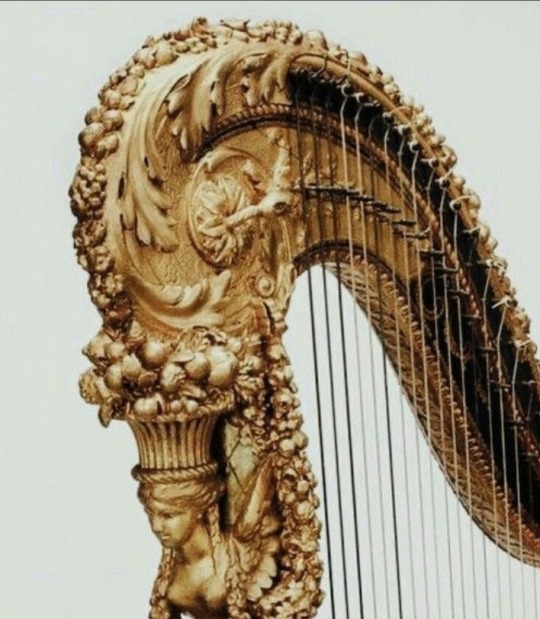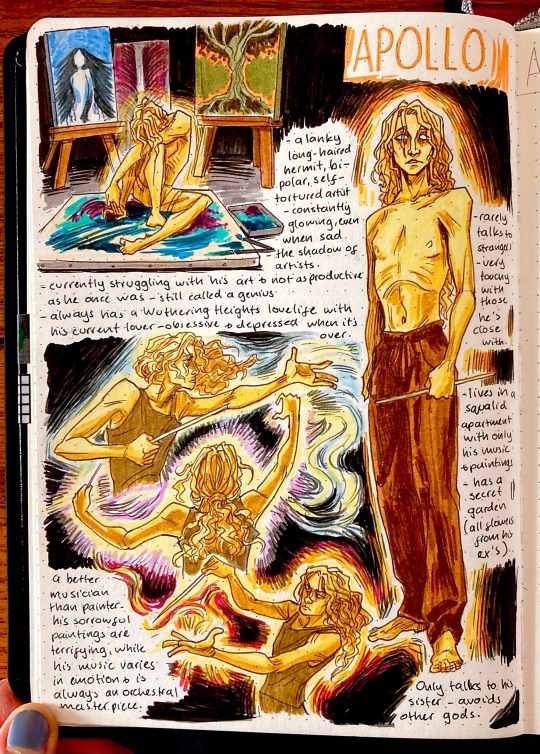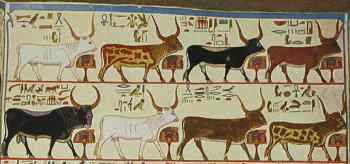#greco roman pantheon
Text
Someday, eventually, I will get an opportunity to talk about Celtic Apollo.
I see a lot of discussions and content (light-hearted and not) talking about Greek Apollo and Roman Apollo but y'all don't understand; it wasn't just that Greek Apollo had a second Roman Apollo hidden in his pocket, it's that Greek Apollo also has a secret third Celtic Apollo hidden behind his back like a tramp stamp he got in college and refuses to acknowledge or show to anyone.
#ginger rambles#Even then it wasn't secret or hidden at all#According to a couple sources but most relevantly Pindar Apollo would spend his winters in Hyperborea because he works entirely too much#the other nine months of the year#Hyperborea was actually England y'all it was England this whole time#It's hilarious btw because obvi Boreas the literal winter wind was the Greeks' big concept of cold? And Hyperborea was considered#even more north than Boreas hence the name and I just love the idea of the thing that is more cold than even winter itself being England#Anyway Celtic Apollo is rad as hell#He was even sycretised into a bunch of other gods because when the Romans came to do their whole conquering thing#(the first time not the time they succeeded)#They were like “gee wilkers y'all have Apollo too :0” and the Celts were like “???” because they didn't speak Latin#Anyway the real secret is that Celtic Apollo is actually at least three other Apollos in a trenchcoat#Namely Maponos Belenus and Lugh (and yes this is a fun little cross cultural equivalency thing#like the greco-egyptian pantheon equivalents#I won't call Horus Egyptian Apollo because it's more like Horus and Apollo co-evolved like brothers separated at birth#But I also definitely want to call Horus Egyptian Apollo because I'm an Apolline menace#ginger chats about greek myths#apollo#greek mythology
37 notes
·
View notes
Note
I am not gay but why do male Greco-Roman statues look better than female ones?
Maybe you aren’t gay, but those sculptors probably were.
#greek mythology#ancient greek mythology#greek pantheon#Ancient Greece#Ancient Rome#greco roman#greek sculpture#roman sculpture#sculpture#statue
13 notes
·
View notes
Text
Christians Are Intolerant
It is well-known that in the Greco-Roman world there was a pantheon of gods. Every group had its own deities, and they were easily and naturally placed alongside other deities. For the most part, no one objected to the existence of other gods. It was a polytheistic world.
Of course, the earliest Christians were as monotheistic as their Jewish predecessors and quite unwilling to play along with the standard religious practices of Greco-Roman culture. For Roman rulers trying to keep the peace, Christian intolerance of other gods was a perennial frustration.
Pliny the Younger, Roman governor of Bythinia (writing c.111-113), expressed his frustration over the fact that Christians would not “invoke the gods.” In a letter to emperor Trajan, he lamented their “stubborness and unyielding obstinancy.” In other words, he was angry over their intolerance.
Why was Pliny so bothered? Because the influence of the Christians had caused the pagan temples to be “deserted” and thus “very few purchasers could be found” for the sacrificial animals.
In other words, they were losing money.
To fix the problem, Pliny decided to force Christians to worship the pagan gods and curse Christ, and if they refused they were put to death
~ Michael J. Kruger
15 notes
·
View notes
Text









Your sweet melody is that of the meadowlark bird, and it is the sweetest hymn I've ever heard.
#Apollo#Apollon#moodboard#deities#pagan#polytheism#polytheist#deity#paganism#roman paganism#hellenic polythiest#hellenism#hellenic deities#hellenic polytheism#roman pagan#greek paganism#greco roman paganism#greek deity#greek god#Greek Pantheon#Roman Pantheon#apollo devotional#devotional moodboard#religio romana#cultus deorum#helpol#paganblr
53 notes
·
View notes
Text

Ares/Mars another one of the ones I don't hate two years later. Yippee
#art#artists on tumblr#small artist#digital artist#digital art#female artists#art tag#artwork#my art#original art#greek myth aesthetic#greek mythology#greek gods#ancient greece#ancient greek#myths#mythology#greek myth art#greek pantheon#greco roman#roman pantheon#roman gods#god art#ares god of war#ares pjo#ares deity#deity#pjo hoo toa#pjo fandom#pjo art
12 notes
·
View notes
Text
#A lot of these could also be UPG#Since I'm also using greco-roman names and in that context#I'm also using Aset/Eset's greco-name of Isis#religious syncretism#syncretism#syncretic goddess#hekate#hecate#isis goddess#artemis#persephone#selene#hellenism#hellenic pantheon#hellenic gods#hellenic community#hellenic paganism#hellenic worship#hellenic polytheism#hellenic polytheist#hellenic pagan#opinion poll#poll
5 notes
·
View notes
Text

Apollo.
(First of idk how many character sheets of my interpretation of the Greco-Roman pantheon).
846 notes
·
View notes
Text
reminder that the only reason the "ADHD is actually demigod BATTLE STRATEGIES" and "dyslexia is DEMIGOD BRAINS HARDWIRED FOR ANCIENT GREEK" things exist in the PJO universe is because it's a very direct reference to early 2000s teaching/parenting techniques for neurodiverse and disabled children, which aimed to frame childrens' disabilities and hardships as a "superpower" or strength so that the children would feel more positively about their disabilities or situations. This technique has fallen out of favor since then for the most part since more often than not it just results in kids feeling as though their struggles are not being seen or taken seriously.
Yes, demigods are adhd/dyslexic (and sometimes autistic-coded) in the series. This is extremely important and trying to remove it or not acknowledge it makes the entire series fall apart because it is such a core concept. Yes, canon claims that their adhd/dyslexia is tied to some innate abilities, which is based on an outdated methodology. It's important to acknowledge that and understand where it comes from! But please stop trying to apply it to other pantheons in the series like "oh, the romans have dyscalculia because of roman numerals!" or "the norse demigods have dysgraphia for reasons!" - it's distasteful at best.
A better option is to acknowledge the meta inspiration for why that exists in the series, such as explaining potentially that Chiron was utilizing that same teaching methodology to try and help demigods feel more comfortable with their disabilities and they aren't literal powers. In fact, especially given Frank, there's implication that being adhd/dyslexic isn't a guaranteed demigod trait, which means it's more likely to be normally inherited from their godly parent/divine ancestor as a general trait, not a power, and further supports the whole "ADHD is battle strategy" thing being non-literal. It also implies the entire greco-roman pantheon in their universe is canonically adhd/dyslexic - and that actually fits very well with the themes of the first series. The entire central conflict of the first series fits perfectly as an allegory about neurodiverse/disabled children and their relationships with their undiagnosed neurodiverse/disabled parents and trying to find solutions together with their shared disability/disabilities that the kid inherited instead of becoming distant from each other (and this makes claiming equivalent to getting a diagnosis which is a fascinating allegory! not to mention the symbolism of demigods inheriting legacies and legends and powers from their parents and everything that comes with that being equivalent to inheriting traits, neurodiversity, and disabilities from your parents).
anyways neurodiversity and disability and the contexts in which the series utilizes representation of those experiences particularly during the 2000s symbolically within the narrative is incredibly important to the first series and the understanding of what themes it means to represent. also if i see one more "the romans have dyscalculia instead of dyslexia" post in 2023 i'm gonna walk into the ocean.
#pjo#riordanverse#percy jackson#analysis#meta#adhd#dyslexia#also this symbolism recontextualizes the relationship between demigods and their godly parents so much#particularly Percy and Poseidon and the whole ''I'm sorry you were born thing'' like DAMN that's an ENTIRE DIFFERENT IMPLICATION#honestly in general the first series' meta analogy of being a demigod as symbolism for being neurodiverse/disabled ROCKS SO HARD#that's SO COOL and im SO SAD NOBODY EVER TALKS ABOUT IT#i could write a whole essay on that alone like COME ON GUYS#can we PLEASE ACKNOWLEDGE THIS I WANNA TALK ABOUT THE COOL DISABILITY METAPHORS....#anyways i didnt proofread this cause. re: dyslexia so if it doesnt make sense dont worry about it#i can try to explain further in supplementary posts if people so wish
3K notes
·
View notes
Text
The lack of pagan Percy Jackson fics is downright criminal
Think about it. Sure there is the comedy of him being a Hellenistic pagan but what if he was literally any other kind of pagan.
Chiron: you are a demigod. The old gods abandoned by modern people are real.
Pagan Percy: old? Abandoned?
————————–—–—————————————–—
Chiron: and now we sacrifice some of our food to the gods
Celtic pagan Percy: oh! alight! I sacrifice this to Danu!
Chiron: not like that!
Danu the mother of the Irish gods: something just happened.
————————–—–—————————————–—
Annabeth: we need a god’s blessing to to do this!
Celtic pagan Percy: does it need to be a Greek god?
Annabeth: it was never specified.
Percy: *pulls out a candle and prays to Morrigan*
Morrigan the Celtic goddess of war: *shows up* yeah sure you have my blessing.
Percy: thank you lady Morrigan.
————————–—–—————————————–—
Jason: do you respect any gods?
Celtic pagan Percy: The only one in the Greco-Roman pantheon that I respect is Hestia
Jason: why did you specify Greco-Roman
Percy: I respect the Celtic gods
Jason: the what?!?
Percy: (:
Jason: D:
#pjo#percy jackson#pjo memes#pjo au#pagan percy#pagan Percy Jackson#jason grace#percy jackson series#pjo stuff#percy pjo#percy jackson and the olympians#percy jackon and the olympians#pjo hoo toa#pjo hoo#annabeth chase#annabeth pjo#pjo chiron
2K notes
·
View notes
Text
Worshipping the gods doesn't have to be super serious devotion level worship all the time. I see some people worry about having "too many deities", but you don't have to have a close relationship with a deity to work with them or pray to them. In fact, it was more common in ancient times to NOT be devoted to any specific deity at all if you weren't some kind of religious figure, like a priest or priestess. Most of the time, there were certain deities that a person would favor, but their worship was not the in-depth type of devotion we see on witchblr a lot. In fact, ancient people sometimes went to a temple for a specific god once in their whole life to pray for something very specific and give offerings and then never needed that specific deity ever again. That's the very nature of these large pantheons. You will have favorites, but even then, you don't NEED to be devoted to them to ask for their help or pray to them.
I say this as mostly a Greco-Roman polytheist, but I'm sure it applies to other large pantheons as well. And, as always, certain gods may be an exception to the rule and require more, both historically and UPG-wise. But it is still a good general rule of thumb. There is no pressure to find a patron or become a devotee of any deity, unless you truly desire to do so.
799 notes
·
View notes
Text



House of the dragon
& the Greco-Roman Pantheon
Part 3.
89 notes
·
View notes
Text
Remembered that one time Michel fell in love with someone just because their Personas were married, so I hurried to make this.

Behold, the Greco-Roman Pantheon.
Ok, the point of this is that Metis would be Lisa's gay awakening.
I pity the Persona User who awakens to Zeus/Jupiter. They will have to walk on eggshells around a good portion of the other Users.
#persona 1#persona 2#persona 3#persona 4#persona 5#yeah... not tagging everyone#i have connected the dots#ulala doesn't know why she feels the need to give dubious life advice to the blonde girl with the pigtails
77 notes
·
View notes
Text

The start of a series of portraits I've made of the Greco-Roman gods and goddesses
#apollo#greek mythology#greek gods#greek pantheon#digital drawing#digital art#digital illustration#original art#greco roman#roman mythology#roman pantheon#phoebus#god art#art#artwork#artists on tumblr#digital artist#small artist#female artists#drawing
3 notes
·
View notes
Text
Hathor Deep Dive
One of the most popular deities in Ancient Egypt and still popular among Kemetic followers today, Hathor (𓉡) is the Egyptian Goddess of women, love, and many other things.
Let’s get to know this Kemetic queen!

Parents and Siblings
Ra is her father in most mythology
Shu (brother)
Tefnut (sister)
Sekhmet (sister)
Mafdet (sister)
Bastet (sister)
Satet (sister)
Anhur (brother)
Ma'at (sister)
Mut (sister)
Lovers or Partners
Due to her role as a “queen” goddess, she often subsumed the role of other goddesses and was commonly said to be the wife of whoever the ruling god of the city was.
Horus the Elder - The most popular version
Thoth - in Hermopolis
Atum
Amun
Khonsu
Children
Ihy
Neferhotep of Hu
Horus the Child (sometimes)
Epithets
Being as popular and ancient comes with many names, here is a non-exhaustive list of some:
Lady of Dendera
Eye of Ra (an epithet shared with other goddesses)
Lady of the sky
Ruler of all gods
Lady of the Two Lands
Lady of bread, who brews beer
Lady of Dance
Ruler of the jba-dance
Lady of drunkenness
Lady of making music
Lady of jubilation
Ruler of joy
The Primeval
The Lady of All
Lady of the West
Lady of the Holy Country
The Foremost One in the Barque of Millions
The Distant Goddess
Hathor of the Sycamore
Lady of the Southern Sycamore
Hathor of the Sycamore in All Her Places
Hathor in All Her Places
Hathor Mistress of the Desert
Hathor Mistress of Heaven
Notes
Hathor’s worship likely started in the early dynastic times.
Her name means “Estate/House of Horus”--referring to both the sky and the royal family.
She is one of the oldest gods in the comedic pantheon.
She is depicted as a woman with a bull's head, a woman with cow ears, a cow, a woman with cow horns and a sundisc.
She was also portrayed as a lioness, a serpent, a papyrus plant and a sycamore tree.
She is associated with the constellation Ursa Major or Mesketiu.
She is regarded as a goddess of love, fertility, marriage and motherhood.
She was also known as a goddess of gratitude and as a sky goddess.
She also represents a vengeful aspect protecting Ra from his enemies.
She would be considered a psychopomp helping deceased souls transition to the afterlife.
In Greco-Roman times, she was seen as a manifestation or another version of Aphrodite.
She is also the goddess of pleasure and music with the sistrum being an important part of her worship.
Her imagery was found often on beer or wine containers, and she is linked to alcohol.
She is often seen wearing a menat, which is a beaded necklace representing rebirth.
Hawthorne's cult became popular in the 4th and 5th dynasty, and her cult believed that she played a huge role in the creation of the universe. They also believed due to her role in the creation of the Earth that she is her own mother.
She was considered to some as being connected to foreign lands.
She is often misrepresented and conflated with Isis.
She was the main deity in Gebelein, Denderah, and had separate temples in Memphis and Heliopolis.
Her most prominent temple was located in Denderah.
In Imu/Kom el-Hisn she was fused with Sekhmet.
Daily offerings were common in Ancient Egypt.
Goods such as incense, semi precious stones and other votive offerings were a part of her worship.
She is connected to the dead and said to nourish those in the afterlife by providing food and milk from her seven sacred cows.

These these seven cows were called the Seven Hawthorns and were named in the Book of the Dead:
Lady of the Universe
Sky-storm
The Hidden One-Presiding Over her place
“You from Khemmis”
Red-hair
Bright-red
"Your Name Prevails Over the West."
The Seven Hathors may or may not also represent the Pleiades constellations. The Seven Hathors were said to have a red ribbon that binds evil.
She was often depicted wearing red, the color of passion.
She is honored in the festival of sacred marriage, which is 18 days into the month of Paoni.
As mentioned earlier, she often absorbed the roles of other goddesses as her popularity grew. Some of these roles included Seshat's role of a witness at the judgment of the dead.
While she was worshiped among all social classes. She was especially popular among the poor.
She had both priests and priestesses, which was uncommon since most clergy had to be the same sex as the god they served.
In the funerary text known as the Book of the Heavenly Cow, her father, Ra, sends her to punish humans for plotting against his rule. She is sent as Sekhmet, the lioness goddess, and massacres the rebellious humans relentlessly. But in order to prevent the wiping out of all of humanity, Ra orders that beer be dyed red and poured all over the land to mimic blood for the (literally) blood-thirsty goddess. Sekhmet then sees the “blood” and drinks all of it. In an inebriated state she passes out and reverts to a benign and calm Hathor.
Correspondences
Rocks/crystals/metals
Selenite, hematite, gold, turquoise
Plants
Papyrus, sycamore tree, lotus flower
Animals
Bull, cow, snake
Symbols
Sistrum, Bull horns with sundisc
Offerings
Milk
Gold
Makeup
Mirrors
Beads
Incense
Stones, especially those worn by royalty in Ancient Egypt such as turquoise or carnelian.
Jewelry
Acts of Devotion
Read the Book of the Heavenly Cow
Daily prayers
Show and share gratitude
Donate either money, clothes, or time to those less fortunate
Dance
Play music
Create a song for her (or a playlist!)
References and Further Reading
Ancient Egypt Online - Hathor
Britannica - Hathor
Hathor and Music
Hathor Epithets
Music and Dance in Ancient Egypt
Mythopedia - Hathor
The Complete Gods And Goddesses of Ancient Egypt by Umair Mirza
The Pleiades: the celestial herd of ancient timekeepers. By Amelia Sparavigna
Wikipedia
88 notes
·
View notes
Text
Depending on what pantheon/mythology you’re looking at if you claim your goal is to kill a god there will be varying degrees of probability and possibility for you.
The things we’re worshipping is kind of the earth and animals and people themselves of course they die (various forms of animism and ancestor worship)
Dying is kind of a promotion in this religion if you’re important enough (some types of Buddhism, Catholicism from certain points of view)
Technically possible to kill a god and it has happened before but you probably won’t be the one to do it (Egyptian, Norse, Aztec, some other polytheistic religions)
Lol and also lmao gods don’t die. You can stab them though. (Greco-Roman mythology)
God(s) became mortal on purpose you’re not special L + Ratio this was part of the plan the whole time (Christianity, some avatar stories in Hinduism)
What are you gonna do? Stab the entire universe? You’re picking a fight with reality itself. Idiot. (Most monotheistic religions)
335 notes
·
View notes
Text
While checking around for my “Roman gods are not Greek gods” posts, I found back this tripartition of mythology, which is actually a fact that everybody should kno about if they want to dabble in Greco-Roman myths (especially Greek myths).
We know that, during Antiquity, the Romans and the Greeks thought that there wasn’t just one, but three different types of “theology” - three different views, perceptions and reception of the gods.
The first theology was the theology of the priests and of the state - aka, religion. The Greek gods as perceived and described by religion, as honored through rituals and festivals.
The second theology is the “mythic theology” - what we call “mythology today”. It is a set of legends, folktales and stories that are not part of religion, but rather used and carried by art - it is the gods are seen, perceived and described by the poets, by the epics, by the theater plays.
The third theology is the theology of the philosophers - who used the gods and their tales as images and allegories for various abstract or concrete topics. It is the gods as depictions and description of natural phenomenon, or the myths as a way to actualy exemplify a social fact or explain psychological workings.
For the classic Greeks and Romans, there was a clear divide between those three very different point of view of the gods. It was basically three different versions of the pantheon. This is notably why you will find texts noting that priests disliked and condemned the poets’ mythological works, due to them being blasphemous and making the gods too human when religion described them as perfect ; and it is also why the philosophers of old dissed on and rejected the literary works of mythology as nonsense only good to feed superstitions, because for them the gods weren’t characters or realities, but rather abstract concepts and rhetorical allegories.
This is something I feel needs to be reminded, because today these three different theologies have been mixed up into one big mess - as literary myths are placed one the same level as philosophical “myths” (actually texts taking the shape of myths), and both considered of outmost religious importance. When in fact, things were quite different...
EDIT: I was asked if there was a myth that could illustrate the three different theologies, and on the spot I would say “the affair between Aphrodite and Ares”.
This story originates from the “mythological theology”. It is primarily a story, and a good one. It is the story of a husband who discovers his wife is unfaithful and tries to get revenge, it is the story of an extra-marital affair gone wrong, it is typical set of divine shenanigans ending on a grotesque display of divine humiliation - it is an excellent narrative material for plays and poems (and the legend does originates from poems).
The story was also dearly beloved and reused by the “philosophical theology”, because the philosophers adored the idea of the love between Ares and Aphrodite - for them it was the perfect depiction of how the concepts of “love” and “war” , despite being seemingly opposite, attracted each other and were closely tied. For them, this story isn’t to be taken literaly as “a god cheated on another god”, but rather as “this is an allegory showing that love and war are two sides of the same coin, which is why Aphrodite falls for Ares despite being married to Hephaistos”. But for them the whole net part is just poetic nonsense invented to make people laugh ; or maybe they will reinvent them as a moral, cautionary tale that should be used to warn people of the dangers of unfaithfulness.
And then there’s the “religious theology”, the point of view of the priests - for whom such a story is mockery and sacrilege. You can imagine them saying: “You are making the gods look like fools! Gods don’t cheat on each other, gods don’t get captured in nets while butt-naked, gods don’t even sleep on beds - GODS DO NOT EVEN HAVE HUMAN FORMS IN THEIR NATURAL STATE - what the heck is this bullshit you’re saying, you’re just insulting the gods by turning them into lecherous humans and grotesque clowns for your vulgar story!” (This is a reconstitution and not the actual words of an Ancient Greek priest)
#greek gods#roman gods#greek mythology#greek religion#roman mythology#roman religion#ancient theology
620 notes
·
View notes